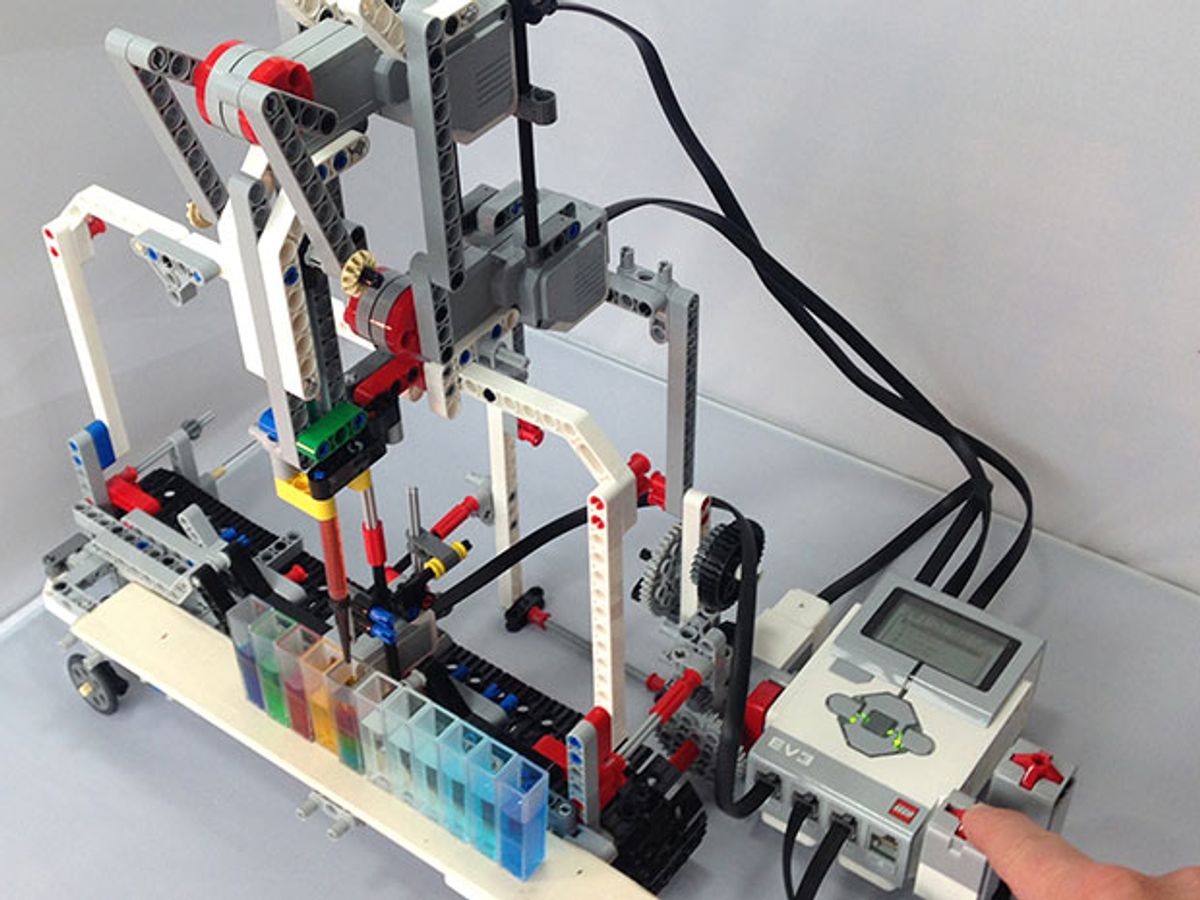In an attempt to get robotics-minded kids more interested in life sciences—and vice versa—Stanford researchers have designed DIY robot kits for automating chemistry experiments. Using a Lego Mindstorms EV3 set and some plastic syringes, students can build robots that measure and transfer liquids, automating their their classroom laboratory assignments. Instructions for building the robot were published Tuesday in the journal PloS Biology.
“What’s key for me is that we merge robotics education—which is loved by kids and teachers—and life sciences education,” says Ingmar Riedel-Kruse, a bioengineer at Stanford who led the project. “Learning should be playful. And maybe it’s more fun to engage in chemistry or biology experiments if you do it with a playful robot.”
Riedel-Kruse and his team built the wet-lab bots using inexpensive syringes and a Lego Mindstorms EV3—a US $390 Lego set that includes a small programmable computer and several motors, sensors, and connecting cables. The team configured the robot so that it can move a syringe from one test tube to the next, drawing up liquid from one and depositing it into another. The robots can be programmed to pipette measured amounts of liquid down to the microliter scale.
The team tested the robots on groups of elementary, middle, and high school students. The youngest group, a Girl Scout troop with kids ages 10-11, were able to build the simple versions of the wet lab bots with guidance from teachers. High school students built more complex designs, including a robot with a stationary syringe and a moving well plate—a plastic plate with multiple small wells for holding liquids that is a staple in life science laboratories.

The robots can be programmed to perform basic science experiments, such as mixing colored liquids, comparing pH levels of liquids, measuring color intensities of liquids or showing how liquids of different salt densities can be layered rather than mixed.
Riedel-Kruse says he hopes to get the robot kits into science classrooms. The National Science Foundation last year awarded him and his collaborators nearly $900,000 to develop teaching material and distribute the kits to schools over the next three years. With help from a non-profit tech education group called Learningtech.org, the team will start with an after-school program involving about ten middle and high school teachers in the San Francisco Bay area. Riedel-Kruse hopes the project will expand beyond California.
The goal is to expose kids to both life sciences and robotics at the same time in the hope that they will carry both into their careers. “Certain students have an aptitude for programming and others for life sciences,” and this is a way to bridge these interests, says Riedel-Kruse.
The Mindstorms concept originated with a 1980 book by MIT professor Seymour Papert. In the book, called Mindstorms: Children, Computers and Powerful Ideas, Papert proposed that computers could enhance learning. In that spirit, members of the MIT Media Lab developed programmable Lego sets and The LEGO Group later commercialized them.
The first Lego Mindstorms construction kit launched in 1998. LEGO revealed the most recent version—the EV3—in 2013. With that redesign, the company aimed to make the set “more hackable.” Indeed, some tinkerers have managed to bypass the controller that comes with the set, replacing it with their own.
With their liquid-handling Lego robots, Riedel-Kruse and his team have perhaps carried on Papert’s vision into the wet sciences: enabling students to learn chemistry and biology through building and programming.
Emily Waltz is a features editor at Spectrum covering power and energy. Prior to joining the staff in January 2024, Emily spent 18 years as a freelance journalist covering biotechnology, primarily for the Nature research journals and Spectrum. Her work has also appeared in Scientific American, Discover, Outside, and the New York Times. Emily has a master's degree from Columbia University Graduate School of Journalism and an undergraduate degree from Vanderbilt University. With every word she writes, Emily strives to say something true and useful. She posts on Twitter/X @EmWaltz and her portfolio can be found on her website.



